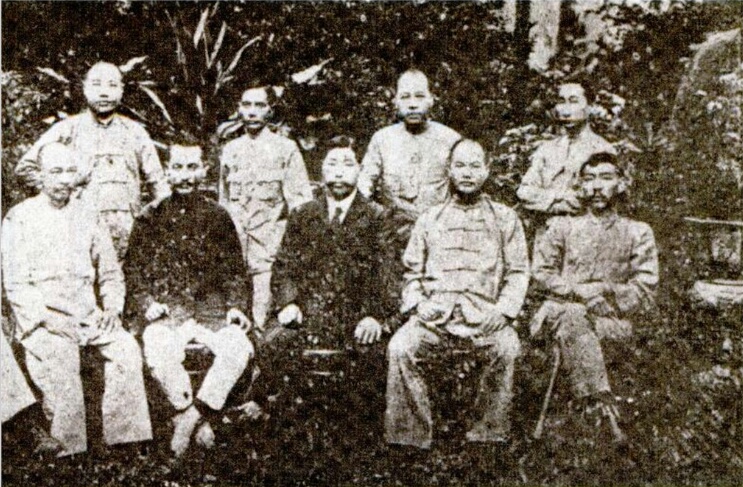72 Martyrs on:
[Wikipedia]
[Google]
[Amazon]
The Second Guangzhou (Canton) Uprising, known in Chinese as the Yellow Flower Mound Uprising or the Guangzhou Xinhai Uprising, was a failed uprising took place in China led by Huang Xing and his fellow revolutionaries against the Qing dynasty in
 At this time
At this time
File:黄花岗b,七十二烈士之墓 - panoramio.jpg, The Mausoleum of the 72 Martyrs, topped by the
Canton
Canton may refer to:
Administrative division terminology
* Canton (administrative division), territorial/administrative division in some countries, notably Switzerland
* Township (Canada), known as ''canton'' in Canadian French
Arts and ent ...
(Guangzhou). It is honored in Guangzhou's Yellow Flower Mound or Huanghuagang Park.
History
 At this time
At this time Malaya
Malaya refers to a number of historical and current political entities related to what is currently Peninsular Malaysia in Southeast Asia:
Political entities
* British Malaya (1826–1957), a loose collection of the British colony of the Straits ...
, which included what is now Peninsular Malaysia and Singapore, had the largest Overseas Chinese population outside of China itself. Many of them were rich and carried out activities for the revolutionaries. On November 13, 1910, Sun Yat-sen, along with several leading figures of the Tongmenghui, gathered at the Penang conference to draw up plans for a decisive battle. The following day on November 14, 1910, Sun Yat-sen chaired an Emergency Meeting of the Tongmenghui at 120 Armenian Street (now the Sun Yat-sen Museum Penang
The Sun Yat-sen Museum Penang ( ms, Muzium Sun Yat-sen Pulau Pinang; ) formerly called the Sun Yat-sen Penang Base, is a museum in George Town, Penang, Malaysia. The museum is dedicated to Sun Yat-sen, a Chinese nationalist who established the ...
) and raised Straits Dollars $8,000 on the spot. The planning events are known as the 1910 Penang Conference
The 1910 Penang conference () was a meeting held at 404 Dato' Kramat Road in Penang on 13 November 1910, by Sun Yat-sen to stage a major revolt. The following day, on 14 November 1910, Sun Yat-sen chaired an Emergency Meeting of the Tongmenghui at ...
. Originally planned to occur on April 13, 1911, the preparations on April 8 did not go as planned, delaying the date to April 27.王恆偉. (2005) (2006) 中國歷史講堂 #5 清. 中華書局. . p 195-198.
Huang Xing and nearly a hundred fellow revolutionaries forced their way into the residence of the Qing
The Qing dynasty ( ), officially the Great Qing,, was a Manchu-led imperial dynasty of China and the last orthodox dynasty in Chinese history. It emerged from the Later Jin dynasty founded by the Jianzhou Jurchens, a Tungusic-speaki ...
Viceroy of Guangdong and Guangxi
Guangxi (; ; Chinese postal romanization, alternately romanized as Kwanghsi; ; za, Gvangjsih, italics=yes), officially the Guangxi Zhuang Autonomous Region (GZAR), is an Autonomous regions of China, autonomous region of the People's Republic ...
provinces. The uprising was initially successful but Qing reinforcements turned the battle into a catastrophic defeat. Most revolutionaries were killed, only few managed to escape. Huang Xing was wounded during the battle; he lost one of his fingers when it was hit by a bullet. 86 bodies were found (but only 72 could be identified), and the bodies of yet many others were not found. The dead were mostly nationalistic, revolutionary youths with all kinds of social backgrounds -- former students, teachers, journalists, and patriotic overseas Chinese. Some of them were of high rank in the Alliance.
Before the battle, most of the revolutionaries knew that the battle would probably be lost, since they were heavily outnumbered, but they went into battle anyway. The mission was carried out like that of a suicide squad. Their letters to their loved ones were later found.
Legacy
The dead were buried together in one grave on the Yellow Flower Mound, a mound near where they fought and died which has lent its name to the uprising. After the Chinese revolution, a cemetery was built on the mound with the names of those 72 revolutionary nationalists. They were commemorated as the "72 martyrs." Some historians believe that the uprising was a direct cause of the Wuchang uprising, which eventually led to the Xinhai Revolution and the founding of theRepublic of China
Taiwan, officially the Republic of China (ROC), is a country in East Asia, at the junction of the East and South China Seas in the northwestern Pacific Ocean, with the People's Republic of China (PRC) to the northwest, Japan to the northeast ...
. Among the martyrs who sacrificed themselves was revolutionary Lin Chueh-min.Langmead, Donald. 011
The following is a list of different international call prefixes that need to be dialled when placing an international telephone call from different countries.
Countries by international prefix
Countries using optional carrier selection cod ...
(2011). Maya Lin: A Biography. ABC-CLIO publishing. , . pg 5-6.
Memorials
The uprising is remembered annually in Taiwan on March 29, as Youth Day.Statue of Liberty
The Statue of Liberty (''Liberty Enlightening the World''; French: ''La Liberté éclairant le monde'') is a List of colossal sculpture in situ, colossal neoclassical sculpture on Liberty Island in New York Harbor in New York City, in the U ...
.
File:黄花岗g - panoramio.jpg, Yellow Flower Mound Park.
In popular culture
The 1980 film ''Magnificent 72'' and the 2011 film '' 72 Heroes'' focus on the uprising. Events of the uprising open the 2011 film ''1911
A notable ongoing event was the Comparison of the Amundsen and Scott Expeditions, race for the South Pole.
Events January
* January 1 – A decade after federation, the Northern Territory and the Australian Capital Territory ...
''.
See also
* Xinhai RevolutionReferences
{{reflist, 30em 1911 in China 1911 Revolution Major National Historical and Cultural Sites in Guangdong History of Guangzhou